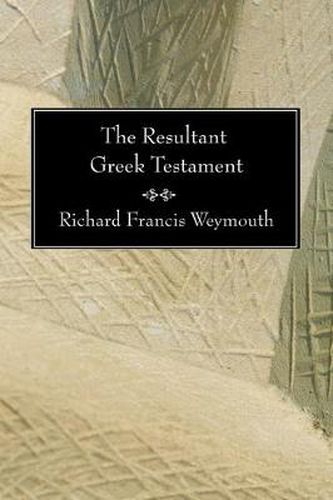Readings Newsletter
Become a Readings Member to make your shopping experience even easier.
Sign in or sign up for free!
You’re not far away from qualifying for FREE standard shipping within Australia
You’ve qualified for FREE standard shipping within Australia
The cart is loading…






This title is printed to order. This book may have been self-published. If so, we cannot guarantee the quality of the content. In the main most books will have gone through the editing process however some may not. We therefore suggest that you be aware of this before ordering this book. If in doubt check either the author or publisher’s details as we are unable to accept any returns unless they are faulty. Please contact us if you have any questions.
‘The Resultant Greek Testament’ is intended to exhibit in a compact and intelligible form the latest results of textual criticism… . I have judged it more convenient to the reader to put in the body of the page the text on which the majority of modern critics are agreed, relegating to the footnotes readings less numerously or less weightily sanctioned.
from the Preface
Weymouth based this majority reading text on the following editions: Lachmann (1842-50), Tregelles (1857-72), Tischendorf (1869-72), Alford (1874-77), the Bale edition (1880), Westcott and Hort (1881), the Revised Version readings (1881), Lightfoot’s Pauline epistles (1865-75), Ellicott’s Pauline epistles (1867-80), and Weiss’s text of Matthew (1876). In addition, Weymouth notes that he made use of Vaticanus, Sinaiticus, and other uncials that earlier editors did not have available. For comparison, he used the Compultusian Polyglot, Robert Stephens’ folio of 1550, and the Textus Receptus.
$9.00 standard shipping within Australia
FREE standard shipping within Australia for orders over $100.00
Express & International shipping calculated at checkout
This title is printed to order. This book may have been self-published. If so, we cannot guarantee the quality of the content. In the main most books will have gone through the editing process however some may not. We therefore suggest that you be aware of this before ordering this book. If in doubt check either the author or publisher’s details as we are unable to accept any returns unless they are faulty. Please contact us if you have any questions.
‘The Resultant Greek Testament’ is intended to exhibit in a compact and intelligible form the latest results of textual criticism… . I have judged it more convenient to the reader to put in the body of the page the text on which the majority of modern critics are agreed, relegating to the footnotes readings less numerously or less weightily sanctioned.
from the Preface
Weymouth based this majority reading text on the following editions: Lachmann (1842-50), Tregelles (1857-72), Tischendorf (1869-72), Alford (1874-77), the Bale edition (1880), Westcott and Hort (1881), the Revised Version readings (1881), Lightfoot’s Pauline epistles (1865-75), Ellicott’s Pauline epistles (1867-80), and Weiss’s text of Matthew (1876). In addition, Weymouth notes that he made use of Vaticanus, Sinaiticus, and other uncials that earlier editors did not have available. For comparison, he used the Compultusian Polyglot, Robert Stephens’ folio of 1550, and the Textus Receptus.